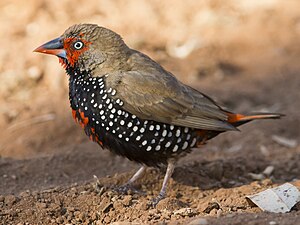Painted amadines
| Painted amadines | ||||||||||||
|---|---|---|---|---|---|---|---|---|---|---|---|---|

Painted amadines ( Emblema pictum ) |
||||||||||||
| Systematics | ||||||||||||
|
||||||||||||
| Scientific name of the genus | ||||||||||||
| Emblema | ||||||||||||
| Gould , 1842 | ||||||||||||
| Scientific name of the species | ||||||||||||
| Emblema pictum | ||||||||||||
| Gould , 1842 |
The Painted Amadine ( Emblema pictum ), also known as the Painted Astrild , is a species of bird from the finch family (Estrildidae). It belongs to the fauna of Australia and occurs there in northern and central Australia . Like all birds in Central Australia, it leads a decidedly nomadic life and migrates great distances in years of drought.
The painted amadine is the only recent representative of the genus of the Prachtastrilde ( Emblema ). No subspecies are distinguished.
description
Painted amadines reach a body length of 10 to 10.5 centimeters. The underside of the body is speckled in black and white, the top is olive brown to olive green. The pointed beak is black above and red below. Males have a red face mask and also have red feathers on the underside of their bodies. Females are similar to males, but have significantly less red in their plumage.
Young birds are similar to the males, but are generally duller in color and they still lack the red on their head and chest. Your drop spots on the underside of your body are still dirty whitish. While the upper bill is already black at the top, the lower bill is initially gray and the base of the beak is whitish.
Distribution area and way of life
The distribution area of the Painted Amadine is the west and the interior of Australia. Its main area of distribution is the Hamersley Range and the Ophthalmia Range . The habitat of the Painted Amadine is one of the driest areas on the Australian continent. Here it is closely tied to the water points, which are mainly found at the foot of steep rock faces. It occurs accordingly in regions that are characterized by chains of hills and rocks. By setting up artificial water points such as cattle troughs and fountains, it has been able to partially expand its living space. It is therefore often found near farms and has been sighted several times in Alice Springs . It is purely a ground dweller, but unlike the quail tribe, it is not able to walk on the ground, but only moves around by hopping on the ground. The flight is vigorous and persistent. Outside the breeding season, it lives in groups of up to 30 individuals.
The diet consists mainly of the seeds of various Spinifex grasses. It also eats insects during the breeding season.
The Painted Amadine has no fixed breeding seasons, but always breeds when the required semi-ripe seeds are available due to rainfall. Painted amadines are free breeders. The nesting material consists of twigs, coconut fiber, grass, vegetable wool, feathers and bark. The nest is built in spinifex bushes and is rarely more than fifty centimeters above the ground. The clutch usually has between three and five eggs. The incubation period is 16 to 18 days. Both parent birds breed. The brood detachment between the two parent birds is indirect: the replacing partner calls, whereupon the brooding parent bird leaves the nest. The young birds are huddled up to about the 10th day of life. Once they have flown out, they do not return to the nest.
attitude
The Painted Amadine was first introduced in England in 1869 and also imported to Germany in 1877 by the animal dealer Christiane Hagenbeck . The bird remained rare for decades and after the Australian export ban in 1960, Europe lacked a sufficiently young population of painted amadines to establish sustainable breeding. Imported birds came from Japan, where the bird was bred. Meanwhile, painted amadines are bred relatively regularly in Europe. In Germany, 336, 190 and 403 young birds of this species were reared in 1995, 1997 and 1998, respectively. The painted Amadine can be kept and also bred in a spacious cage or in aviaries. She does not make any great demands on the feed. All that is needed is a fine-grain finch feed, egg feed and red millet. The red millet is particularly important for breeding. Between 3 and 5 eggs are incubated for about 15 days. After hatching, the young birds are fed by the adults for 3 weeks.
supporting documents
literature
- Horst Bielfeld : Knowing and caring for 300 ornamental birds. Ulmer Verlag, Stuttgart 2009, ISBN 978-3-8001-5737-2 .
- Jürgen Nicolai (Ed.), Joachim Steinbacher (Ed.), Renate van den Elzen, Gerhard Hofmann: Prachtfinken - Australia, Oceania, Southeast Asia . Eugen Ulmer Verlag, Stuttgart 2001, ISBN 3-8001-3249-4 .
- Peter Clement , Alan Harris, John Davis: Finches and Sparrows. An Identification Guide. Christopher Helm, London 1993, ISBN 0-7136-8017-2 .
Web links
- Emblema pictum inthe IUCN 2013 Red List of Endangered Species . Listed by: BirdLife International, 2012. Retrieved November 24, 2013.
